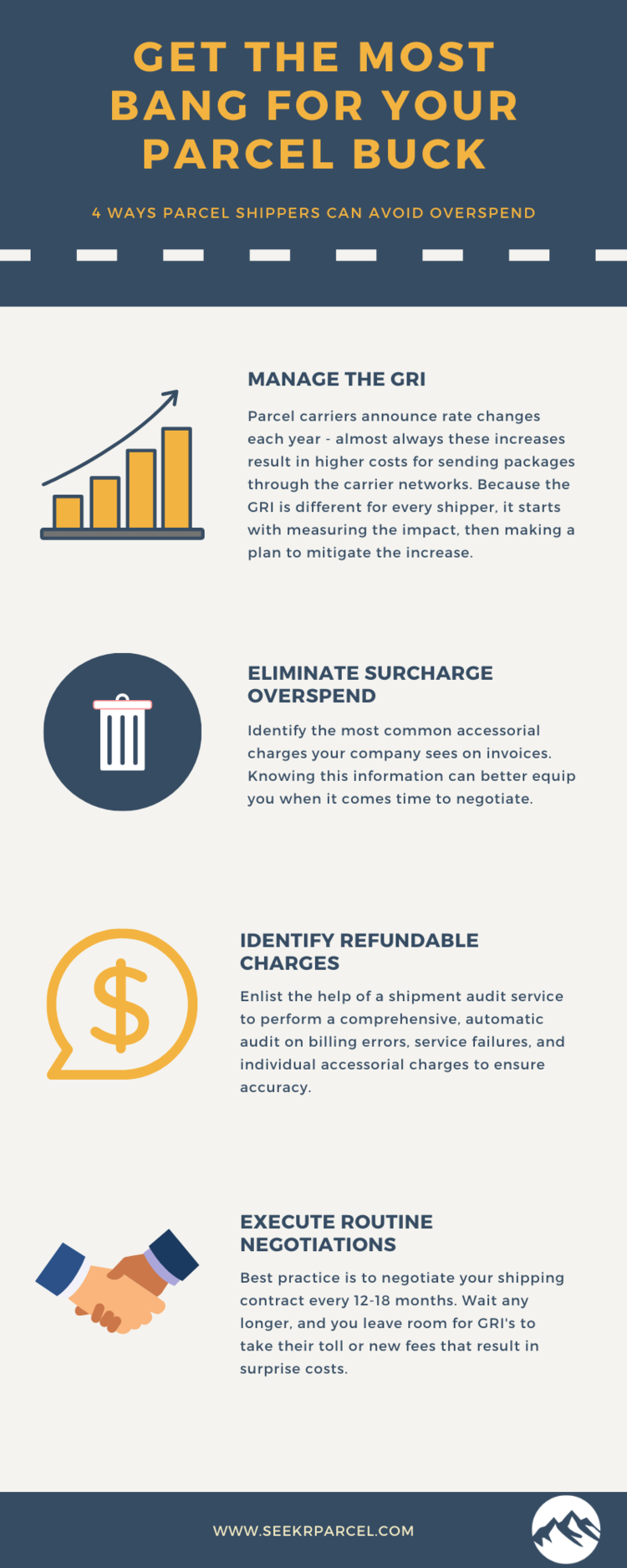2021 has set the stage for a unique shipping climate. COVID has been a catalyst for exponential e-commerce growth, and traditional brick-and-mortar stores have taken a back seat to the increasing popularity of online shopping carts. With more than 25% of shopping now done online, retailers are looking for ways to get their products to the masses faster, and more affordable.
There are a few problems though. Historically, shipping costs were passed on to the end consumer. But now with shopping cart abandonments at an all-time high, and our friends over at Amazon, it is ludicrous to think the consumer will pay high shipping costs and still remain a happy client.
The moral of the story: Someone has to pay for the shipping, and the parcel carriers are making sure as the shipper, that is you.
Here are 4 ways you can avoid overspend on your shipping costs in 2021, and get the most bang for your parcel buck.
Don’t feel like reading everything? Check out our infograph.

(1) Manage the General Rate Increase:
Parcel carriers announce rate changes each year – almost always these increases result in higher costs for sending packages through the carrier networks. In 2021, carriers announced an increase of 4.9%. Keep in mind, the published increase does not include accessorial surcharges or any other ancillary fees. Budgeting 4-6% into next year’s shipping spend used to be a reliable tactic to estimate future costs. In today’s shipping shipping climate of volume restrictions (due to carrier networks being flooded), peak season surcharges, and the implementation of new fees, that is no longer an accurate measure.
A few fees to watch out for this year include FedEx’s 6% late payment fee, which will apply to invoices that extend beyond agreed-upon payment terms. UPS, on the contrary, has had the 6% fee in place for years. The carriers have also placed emphasis on large packages, and packages that require additional handling (not included in the 4.9% increase).
Solution: Because the GRI differs for every shipper, it starts with measuring the impact, then making a coordinated effort to mitigate the increase.The key is to analyze the full impact the GRI will have on your spend, then work with your rep to reduce or eliminate some of the upcharges. Many shippers take the increase at face value, but there are many strategies to reduce these costs, whether its placing a “rate cap” on the GRI or requesting a reduction on transportation costs/surcharges.
You can read more on the 2021 GRI here.
2) Eliminate Surcharge Overspend:
Identify the most common accessorial charges your company sees on invoices. Knowing this information can better equip you when it comes time to negotiate. It’s important that you keep a trained eye on your invoices to make sure surcharge fees don’t get the best of you. Take the Over Max Limits/Unauthorized Oversize Fee that both UPS/FedEx implemented over the last several years.
This fee started at $55/package in 2015. The 2021 fee for that same package would be $920…a 1500% increase!
Solution: Be vigilant on invoices. If there is a common surcharge that impacts your business, be prepared to negotiate it out of your contract. Another tactic is to request the reduction as part of a continuous improvement measure. For example, if you do get hit with the occasional Unauthorized/Over Max Limits fee (as noted above), you may consider asking for a reduction by saying you’re actively working with your team to reduce box sizes. When carriers see you are making a conscious effort, they’re more willing to work with you.
3) Identify Refundable Charges
Enlist the help of a shipment audit service to perform a comprehensive, automatic audit on billing errors, service failures, and individual accessorial charges to ensure accuracy. You don’t have to rely on clunky carrier data – savvy shippers use third party platforms to access and analyze their data. Most of the time these companies have no charge to pull reports and gain better visibility to your data.
4) Execute Routine Negotiations
Good things come to those who ask. Here’s the thing about parcel shipping contracts. If you don’t ask for it, or don’t know what to ask for, you probably won’t see it in your contract. The smallest item in your carrier agreement can have a very large financial impact, so it’s important to review your agreements with a fine-tooth comb, and be prepared when it’s time to negotiate.
Best practice is to negotiate your shipping contract every 12-18 months. Wait any longer, and you leave room for GRI’s to take their toll or new fees that result in surprise costs.
More negotiation strategy here.









